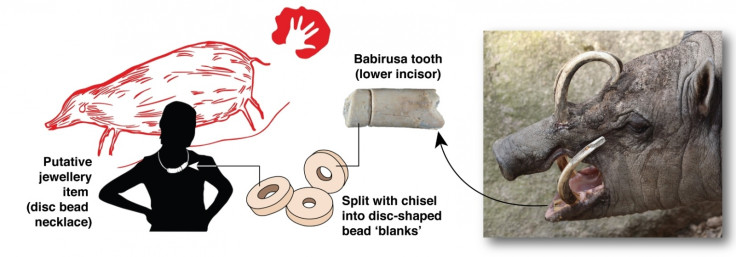30,000-year-old art and jewellery in Wallacea shows first complex human culture in Sulawesi
Beads and a pendant were made from the bones of the bear cuscus and teeth of the pig-deer.
A pendant, carved stone discs and a hollow bone thought to have been used as an airbrush for rock art have been discovered in Wallacea, Indonesia, marking the first discoveries of 'portable art' in the region dating from the Pleistocene.
The artefacts were discovered in the Leang Bulu Bettue cave and rock shelter on the island of Sulawesi. The island is in the Wallacea region of Indonesia, which had been colonised by humans by about 47,000 years ago. The Wallacean islands have a total land area of nearly 350,000 square kilometres today.
There have been remarkably few discoveries of decorative objects and other cultural artefacts from this period in the Wallacean islands until now. A series of discoveries at the island of Sulawesi, published in a paper in the journal PNAS, mark some of the first evidence of a complex human culture in the region.
The finds include a perforated pendant made of bone from a bear cuscus, a type of small marsupial. It dates from about 26,000 to 22,000 years ago. It still shows the remains of a notch used to string it along a thread to be worn around the neck. It is shiny on one side where it has been worn down by rubbing on the person's skin or clothing.
A disc-shaped bead found at the site is even older, dating from about 30,000 years ago. The beads were made from the lower incisor of a babirusa, or pig-deer. An inner central cavity of the tooth makes a natural hole, and the object was shattered into smooth circular flakes. The sides of the beads don't appear to be worn, suggesting that the beads were rejected or thrown away shortly after they were made.
Five stones, which are between 22,000 and 30,000 years old, were found with a V-shape carved into them. One stone fragment has traces of red ochre, suggesting it may have been painted. A hollow bone also with traces of red and black pigment is thought to have been a blowpipe for creating stencil rock art.
"Previously, assemblages of multiple and diverse types of Pleistocene 'symbolic' artefacts were entirely unknown from this region," the authors, led by Adam Brumm of Griffith University, Australia, write in the paper.

"The Leang Bulu Bettue assemblage provides insight into the complexity and diversification of modern human culture during a key period in the global dispersal of our species.
"It also shows that early inhabitants of Sulawesi fashioned ornaments from body parts of endemic animals, suggesting modern humans integrated exotic faunas and other novel resources into their symbolic world as they colonised the biogeographically unique regions southeast of continental Eurasia."

© Copyright IBTimes 2025. All rights reserved.






















